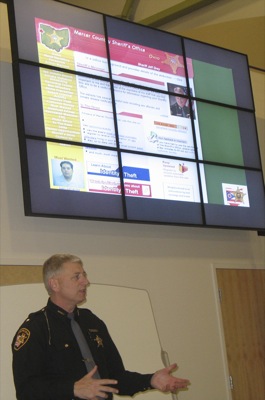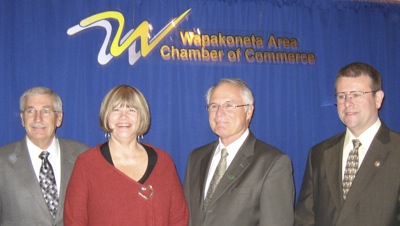Friday, November 5th, 2010
Commercial carp fishing part of lake restoration plan
By Nancy Allen
GRAND LAKE - A new master plan to restore Grand Lake compiled by the Lake Restoration Commission (LRC) proposes commercial fishing of carp and gizzard shad, known as rough fish.
Jared Ebbing, Mercer County Community Economic Development director, spoke about the idea during Thursday's monthly Mercer County agriculture breakfast meeting in Celina.
Ebbing said studies show that reducing the number of rough fish helps improve water quality and decrease algae blooms. The overabundance of rough fish, representing perhaps as much as 95 percent of the lake's fish population, is contributing to the lake's out-of-balance ecosystem, he said.
Commercial fishing is just one part of the LRC's master plan, which is a compilation of 14 existing plans/studies on the lake. The LRC was formed in January as a volunteer coalition to address the toxic blue-green algae blooms that nearly shut down the 13,500-acre lake this summer.
LRC officials have said consultant Battelle Institute has done studies showing eliminating rough fish helps decrease blue-green algae blooms.
Rough fish are bottom feeders that continually rile up the lake sediment and phosphorous, Ebbing said. The fish also eat phytoplankton and zooplankton - robbing game fish of their food source - and excrete waste that is high in dissolved phosphorous.
"You harvest those fish, get commercial fisherman to come in and catch them, they get to keep the fish, grind them up into fertilizer or whatever. Carp derbies will help, but with the high level of those fish, it's going to take a widespread commercial operation," Ebbing said.
The most common use for commercially caught carp and shad is as crop fertilizer. It also could be sold into the Asian food market, but the state would need to first prove it is safe for consumption, Ebbing said. The state currently is doing studies to make sure the blue-green algae toxins in the lake are not in the fish tissue. Another use for carp is as crab bait in southern states, Ebbing said.
Ebbing said a lake in Minnesota suffering from algae blooms used a two-step process that included first dosing the water with alum followed by removing rough fish. The lake has not had an algae problem in 15 years, he said. Alum binds up phosphorous in the water and causes it to sink to the bottom, making it unavailable to blue-green algae as a food source.
Ebbing said he has spoken with state officials in Columbus about having commercial fishing on the lake, but they have been slow to react because they are focused on the lake's alum study. A state permit is required to conduct commercial fishing.
If alum is proven to work at Grand Lake, the state has said it would do a whole lake treatment this spring. The alum pilot study is going on near the Celina Rotary Lighthouse.
Ebbing said he hopes once the LRC submits its master plan that contains scientific data on the benefits of rough fish removal, the state will be more receptive to allowing commercial fishing.
"We need to show them the technical data to help them decide," Ebbing said.
In a related matter, Brian Miller, assistant manager of Grand Lake St. Marys State Park, said the LRC soon will send a letter to local chambers of commerce and sportsmen groups asking them if they are interested in coordinating a carp derby on the lake next year.
Local state park officials have said their office could easily supply the special activities permit to allow the carp fishing event, once commonplace on the lake in the 1940s and 1950s.
"We would want a multiple day derby so people will come and spend at least a couple of days with us, stay in motels, eat at our restaurants, buy gas, all the things we need," Miller said.
Ebbing said he doesn't want people to think eliminating rough fish from the lake is the silver bullet that will restore it, but rather just one component. The LRC's plan contains numerous measures that when combined should help, he noted.
The next agriculture breakfast meeting is 7:30 a.m. Dec. 2 at the Mercer County Central Services Building in Celina.




